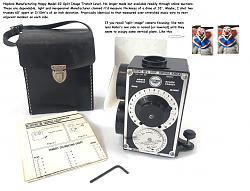Not only correct, Marv, precisely so. Genau.
On lathe beds, the Vee's are not in plane to the flats. Use 1-2-3's or two of any identical materials higher than Vee's interfere. Whatever checks are made longwise, check as many 90° to bed. This labor results in superior, or at least enhanced, machine performance.
Sensitivity is everything speaking of bubble levels. Good as their #98 is, the 199Z is .0005 per foot, Mitutoyo has one higher yet, at .0002 per foot!
A user could determine some degree of sensitivity on any level on a decent clean surface, two 1-2-3 blocks, an accurate scale/ tape, and feeler gauges. By spacing blocks a known distance apart, get an apparent level reading with paper shims at one end, then create an incline via feelers. A half bubble is conveniently interpolated once you know what combined stack of feelers generates it.
When leveling machinery, I start off with two decent construction grade [torpedo] levels and a bullseye. Orientation of torpedoes is parallel to machines X and Y. I add a bullseye when both are not easily seen from one position, a monitor. Then I break out 2 precision levels. You can save a lot of steps and crawling around with feeler gauges. Whatever deflection a bubble shows, lift lower side with a feeler to zero, lets say .007 works for 1 foot. If the leveling screws are 3 feet apart, low side needs roughly .021 for level [remember to remove feeler!]. If screws are not spaced so conveniently, divide the amount needed [in 1 foot] by 12, and multiply that for screw spacing. Example = .007/12 is 0005834 [rounded] x 54" is .031.
There are two well known ways to measure lift or lowering. 1) Bandsaw a shallow taper leaf of steel. Push it under base till interference is felt. Mark that with felt-tip or red pencil. Measure with a caliper. 2) Determine the pitch of elevation screws, calculate what 1/2 and 1/4 turns deliver as movement. Paint a small dot on the head to render control of turns.
I employ both together, some bases have a LOT of screws!
Any transit short of theodolite or collimator seems hard pressed to interpret accuracy over something short as a lathe bed, within confines of your building, and certainly at a height not comfortable for viewing. Even less so across the bed. Probably fine for initial set up, placing a stock feeder, etc.
Surveyors read over distance that will create a significant sine figure, checked to the range rod. Subsequent placements reinforce the calculations.



 LinkBack URL
LinkBack URL About LinkBacks
About LinkBacks


 Reply With Quote
Reply With Quote



Bookmarks